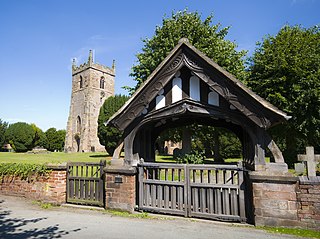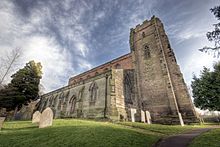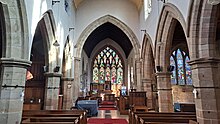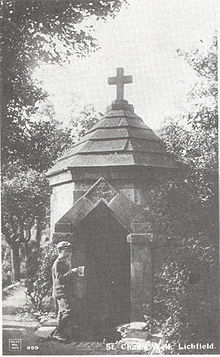
Beachamwell is a village and civil parish in the Breckland district of Norfolk, England about 5 miles (8.0 km) south west of Swaffham and 10 miles (16 km) east of Downham Market. It has four ancient churches, two of them in ruins. The former parish of Shingham has been annexed.

St Michael's Church is a Church of England parish church in St Albans, Hertfordshire, England. Much of the building is late 10th or early 11th century, making it the most significant surviving Anglo-Saxon building in the county. It is located near the centre of the site of Roman Verulamium to the west of the modern city.

St Leonard's Church is in Sandridge, a village in Hertfordshire, England. It is an active Anglican parish church. The building is Grade II* listed: notable features include its chancel arch made from recycled Roman brick.

St. Mary's Church, Blymhill is an Anglican church in the village of Blymhill, Staffordshire, England. The building, which is a Grade I listed building, was constructed in the 14th century and restored and extended in the 18th and 19th centuries. It features an Early English south aisle, a Decorated Gothic chancel and a Perpendicular Gothic tower.

The Church of St Mary Magdalene is the Church of England parish church for the village of Ditcheat, Somerset, England. There has been a church on the site since 824, and the present building owes much of its grandeur to the Abbots of Glastonbury. Historic England have designated it a Grade I listed building.

St Kentigern's Church,, is in the village of Caldbeck, Cumbria, England. It is an active Anglican parish church in the deanery of Carlisle, the archdeaconry of Carlisle and the diocese of Carlisle. The church is recorded in the National Heritage List for England as a designated Grade I listed building. It is dedicated to Saint Kentigern, whose alternative name is Saint Mungo; hence the church's alternative title of Caldbeck, St Mungo.

All Saints Church, Alrewas is a parish church in the village of Alrewas, Staffordshire in the United Kingdom. The church is situated in the north west of the village on the north side of the Trent & Mersey Canal. The church is a Grade I Listed Building. A church has stood on the current site since the 10th century. The current building was mainly built during the 13th, 14th, 16th and 19th centuries.

St Michael on Greenhill is a parish church in Lichfield, Staffordshire in England, located on the high ground of Greenhill in the east of the city. A church has been on the present site since at least 1190 but the current building dates mainly from the restoration of 1842–43. The churchyard is one of five ancient burial grounds in England and is one of the largest churchyards in the country at 9 acres (36,000 m2).

St Gregory's Church is a redundant Anglican church in Fledborough, Nottinghamshire, England. It is recorded in the National Heritage List for England as a designated Grade I listed building, and is under the care of the Churches Conservation Trust. The church stands at the end of a lane, in meadows near the River Trent.

St Mary's Church is a redundant Anglican church in St Mary's Place, Shrewsbury, Shropshire, England. It is recorded in the National Heritage List for England as a designated Grade I listed building, and is under the care of the Churches Conservation Trust, the Trust designated St Mary's as its first Conservation Church in 2015. It is the largest church in Shrewsbury. Clifton-Taylor includes the church in his list of 'best' English parish churches.

St Mary's Church is a redundant Church of England parish church in the village of Garthorpe, Leicestershire, England. The building is Grade I listed. It has been in the care of the Churches Conservation Trust since 1 November 1999.

St Michael and All Angels Church is a redundant Anglican church in the village of Edmondthorpe, Leicestershire, England. It is recorded in the National Heritage List for England as a designated Grade I listed building, and is under the care of the Churches Conservation Trust.

St Lawrence's Church is a redundant Anglican church in the centre of the town of Evesham, Worcestershire, England. It is recorded in the National Heritage List for England as a designated Grade II* listed building, and is under the care of the Churches Conservation Trust. It stands close to All Saints Church, and to the bell tower of the former Evesham Abbey.

St Nicholas Church is a redundant Anglican church in the village of Feltwell, Norfolk, England. It is recorded in the National Heritage List for England as a designated Grade I listed building, and is under the care of the Churches Conservation Trust. It has a partly collapsed west tower, and is unusual in being broader than it is long, having two side aisles and no chancel.

St Peter's Church is a redundant Anglican church in the village of Hockwold cum Wilton in Norfolk, England. It is recorded in the National Heritage List for England as a designated Grade I listed building, and is under the care of the Churches Conservation Trust.

The Church of St Michael and All Angels is a parish church and Grade I listed building in the village of Hamstall Ridware, Staffordshire. The church is situated in a remote position to the north of the village accessed by a 250 m (820 ft) pathway through pasture land. The church is situated on a gentle slope 160 m (520 ft) west of the River Blithe. The church was founded in 1130—1150 but the majority of the present church was built of ashlar sandstone in the 14th and 15th centuries.

The Church of St Andrew is a Grade I listed church in the village of Clifton Campville, Staffordshire. It was built in the 13th and 14th centuries. The tall spire is a notable feature, visible from a great distance.

St James the Great Church is a Grade I listed Church of England parish church dedicated to James, son of Zebedee in Aslackby, Lincolnshire, England. The church is 7 miles (11 km) north from Bourne, and in the Aslackby and Laughton parish on the eastern edge the South Kesteven Lincolnshire Vales.

Holy Trinity Church in Eccleshall, Staffordshire, England, is a Grade I listed Anglican church.

St Lawrence's Church is an Anglican church in Gnosall, Staffordshire, England. It is a Grade I listed building. The earliest parts of the church are of Norman architecture; it was later much modified. The church is unusual in having a central tower.

























